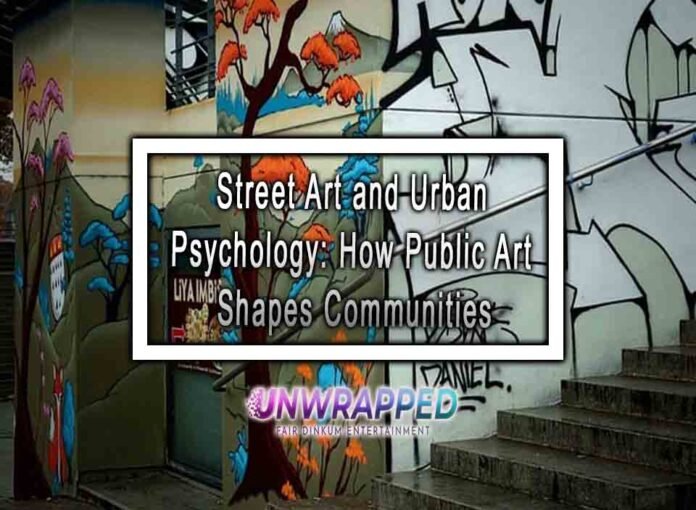Urban environments are more than mere physical spaces; they are the heartbeat of culture, emotion, and identity. In this context, street art has emerged as a transformative force, breathing life into cities and reshaping how people perceive their surroundings. Beyond its aesthetic appeal, street art influences urban psychology by evoking emotions, fostering connections, and giving a voice to marginalized communities.
This article delves into the profound impact of street art on urban psychology and community identity. From its role in enhancing mental well-being to its ability to create a shared sense of belonging, we’ll explore the multifaceted ways street art transforms cities and the lives of those who inhabit them.
The Evolution of Street Art
Origins and Growth
- Graffiti Roots: Street art evolved from graffiti culture in the 1970s, beginning as a form of rebellion and self-expression.
- Global Expansion: Over time, it became a global movement, blending visual art with activism, storytelling, and cultural preservation.
Modern-Day Street Art
- From Subversive to Mainstream: Today, street art is celebrated in galleries and public art projects.
- Cultural Significance: Artists like Banksy, Shepard Fairey, and JR have elevated street art to a platform for political and social discourse.
The Psychological Impact of Street Art
Enhancing Mental Well-Being
- Mood Elevation:
- Bright colors and creative designs can reduce stress and enhance feelings of joy.
- Murals like “Before I Die” by Candy Chang invite introspection and connection.
- Breaking Monotony:
- In grey, monotonous urban landscapes, street art offers visual stimulation and relief.
- Art-filled spaces like Wynwood Walls in Miami attract visitors, boosting emotional engagement.
Sparking Emotional Responses
- Connection to Stories: Many works tell stories or address societal issues, evoking empathy and reflection.
- Nostalgia and Identity: Local references in murals can foster pride and a deeper connection to the neighborhood.
Street Art and Community Identity
A Platform for Marginalized Voices
- Representation Matters: Street art allows underrepresented groups to share their narratives and experiences.
- Examples: Murals honoring Indigenous communities or celebrating LGBTQ+ pride create inclusivity and representation.
Building a Shared Sense of Belonging
- Community-Led Projects: Collaborative murals, like those by Artolution, encourage local participation and unity.
- Visual Landmarks: Iconic pieces often become symbols of identity for neighborhoods, such as Philadelphia’s Mural Arts Program.
Street Art as a Catalyst for Urban Renewal
- Revitalizing Neglected Areas:
- Street art transforms rundown spaces into vibrant cultural hubs.
- Example: The transformation of Shoreditch in London into an artistic hotspot.
- Boosting Local Economies:
- Art districts attract tourism, restaurants, and businesses, revitalizing local economies.
- Case Study: The Heidelberg Project in Detroit draws visitors worldwide.
- Encouraging Civic Pride:
- Public art fosters a sense of ownership and pride among residents.
- Collaborative works often involve input from diverse community members.
The Sociopolitical Role of Street Art
Addressing Social Issues
- Street art serves as a medium for activism, raising awareness about topics like:
- Climate change (e.g., works by Escif).
- Racial justice (e.g., “Black Lives Matter” murals).
- Gender equality.
Challenging Authority
- Historically, street art has been a tool for dissent, challenging oppressive systems and sparking dialogue.
- Examples:
- Banksy’s anti-capitalist and anti-war themes.
- Murals supporting the Arab Spring uprisings.
The Challenges of Street Art
- Legality and Perception:
- Many cities still view street art as vandalism, leading to restrictions and fines.
- Artists often walk the fine line between public appreciation and legal challenges.
- Commercialization:
- As street art gains popularity, its authenticity can be compromised by commercialization.
- Brands often co-opt street art styles for marketing, diluting its grassroots essence.
- Preservation vs. Ephemerality:
- While some works are preserved, many are temporary, sparking debates about art’s permanence in urban spaces.
Street Art and Urban Psychology: Key Case Studies
- Favela Painting Project, Brazil:
- Transformed impoverished neighborhoods with colorful murals, fostering community pride and reducing crime rates.
- JR’s “Inside Out” Project:
- Global art initiative encouraging individuals to share their portraits and stories, empowering communities worldwide.
- Bogotá, Colombia:
- Decriminalization of graffiti led to a flourishing street art scene, creating a unique identity for the city.
The Future of Street Art
- Integration with Technology:
- Augmented reality (AR) and projection mapping enhance interactive experiences, such as AR murals viewable via smartphones.
- Eco-Friendly Art:
- Increasingly, artists use sustainable materials and techniques, like moss graffiti and biodegradable paints.
- Global Collaborations:
- Digital platforms enable artists from different countries to collaborate, creating multicultural masterpieces.
- Street Art Festivals:
- Events like POW! WOW! and Upfest continue to celebrate and expand the reach of street art globally.
Conclusion
Street art is far more than decoration; it’s a vital form of expression that shapes urban landscapes and the minds of those who inhabit them. By enhancing mental well-being, fostering community identity, and addressing societal issues, it proves the transformative power of creativity in public spaces.
As street art continues to evolve, it challenges us to rethink the relationship between art, community, and city life. Whether through a colorful mural on a building or a politically charged graffiti piece, street art captures the soul of a city, leaving an indelible mark on its culture and collective psyche.
References
- Riggle, N. A. (2010). Street Art and the Aesthetic Identity of a City.
- Young, A. (2014). Street Art, Public City: Law, Crime and the Urban Imagination.
- Articles from Art in the Streets exhibition catalog.
- Studies from the Journal of Urban Affairs.
- Online resources like StreetArtNews and Mural Arts Philadelphia.
See Also: Memes as Modern Art: A Study of Expression in the Internet Era










